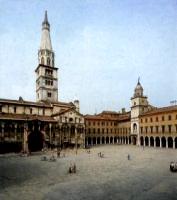|
|
Piazza Grande |
|
|
|
|
The square used to be the site of the weekly market governed by the statutes issued in 1327 and held on Saturday until the day was changed to Monday by the French in the 1790s. On these occasions, the Piazza Grande was a colourful meeting place. However, in the early 1900s this colour was seen as a heath risk and unattractive, and unworthy of a square next to such a splendid cathedral. And so in 1931 the fruit and vegetable market was transferred to the new covered premises in Via Albinelli, well worth a visit for anyone interested in the daily life of Modena.
The Monday weekly market is still a feature of life in Modena, but now it is held in Parco Novi Sad, also the venue for the antiques market on the fourth Saturday and Sunday of each month, except for July, August and December. However, Piazza Grande still plays an important role in Modena's traditions, as people cram into it on the feast day of S. Geminiano, the local patron saint (31 January) and on "giovedě grasso", the Thursday before Shrove Tuesday, when a member of the local dialect association dresses up to impersonate "Sandrone", a peasant character supposed to personify the Modenese identity, and addresses the crowd in dialect from the balcony of the town hall. These are almost the only occasions when the square can be seen with its old bustle of stalls, awnings and people, as life makes a colourful return to an area which is no longer the commercial heart of the city. Piazza Grande's former role in civic life is reflected by the "ringadora" stone in its north east corner, in front of the stairway of the town hall, traditionally the pulpit from which speeches used to be made to the assembled populace. In a later period the stone acquired a different function: debtors used to have to beat on it three times with bare buttocks as a sign of humiliation, and the bodies of the drowned were placed on it to await recognition. The standard measures of the pole, yard, roofing-tile and brick are still carved on the apse of the cathedral opposite the "ringadora", reflecting the square's past status as the centre of economic life.
|
|
© 1997 - Provincia di Modena - Made by
|
|
 The market hall offers a starting
point for a stroll around the city in search of the work of the
local sculptor G. Graziosi, almost all dating from the 1930s.
The "Girl with a basket of fruit", a solid female figure
standing amongst the market stalls, is his work, while just outside
the building in piazza XX Settembre a fountain is topped by a
bronze cherub with real youthful charm. (However the figure is
a copy; the original, together with many plaster models, including
the preparatory works for the statues on the Palazzo Ducale, can
be seen in the Gipsoteca Graziosi in the Palazzo dei Musei).
Graziosi's best known work is the fountain in Largo Garibaldi,
with opulent male and female nudes symbolising the Secchia and
Panaro rivers. Also dating from 1938, but very different in tone
from all this abundant sensuality, is the thin figure of S. Francesco,
bending to pray to the birds, on the fountain of the piazza which
has taken his name. A fountain now in Largo S. Giacomo carries
another well rounded female form.
The market hall offers a starting
point for a stroll around the city in search of the work of the
local sculptor G. Graziosi, almost all dating from the 1930s.
The "Girl with a basket of fruit", a solid female figure
standing amongst the market stalls, is his work, while just outside
the building in piazza XX Settembre a fountain is topped by a
bronze cherub with real youthful charm. (However the figure is
a copy; the original, together with many plaster models, including
the preparatory works for the statues on the Palazzo Ducale, can
be seen in the Gipsoteca Graziosi in the Palazzo dei Musei).
Graziosi's best known work is the fountain in Largo Garibaldi,
with opulent male and female nudes symbolising the Secchia and
Panaro rivers. Also dating from 1938, but very different in tone
from all this abundant sensuality, is the thin figure of S. Francesco,
bending to pray to the birds, on the fountain of the piazza which
has taken his name. A fountain now in Largo S. Giacomo carries
another well rounded female form.